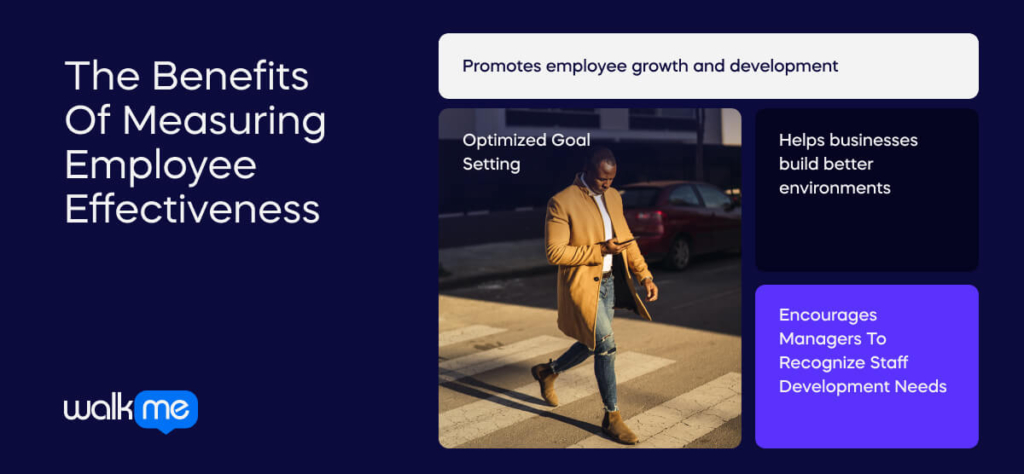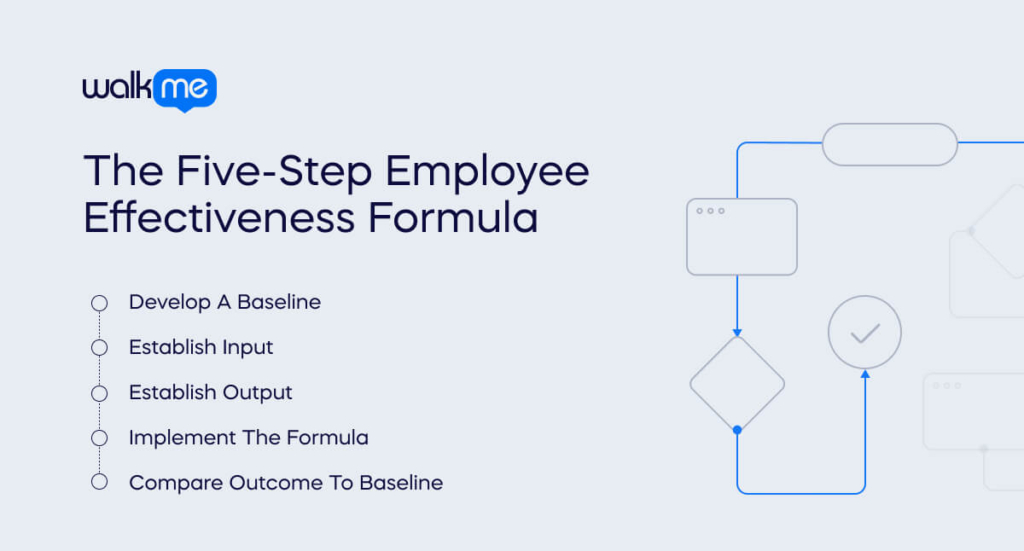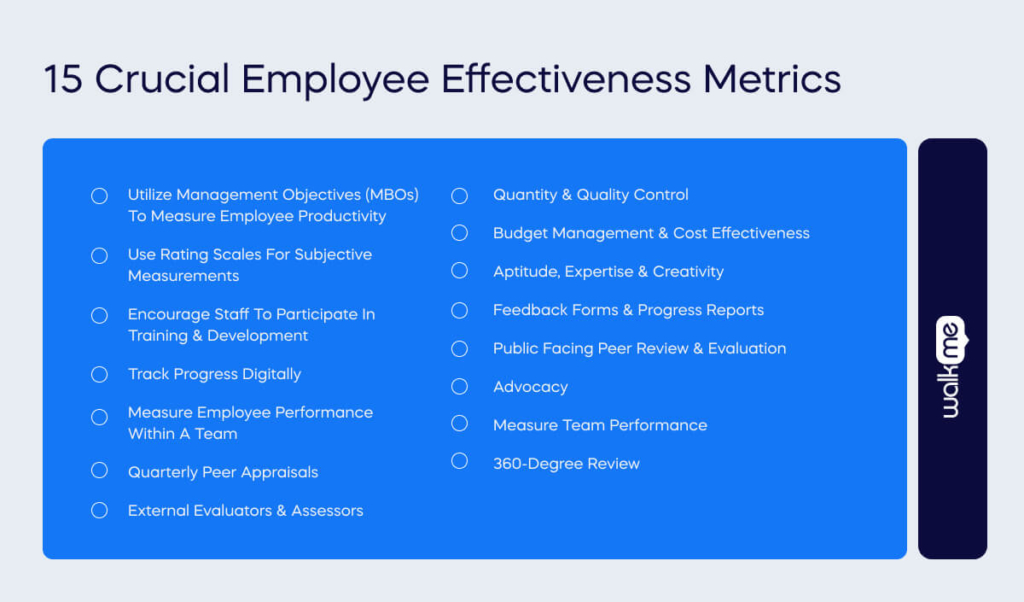As we forge ahead, measuring employee effectiveness remains a key focus for businesses worldwide. Reflecting on the transformative years of 2019 to 2022, it’s clear that our approach to assessing productivity and performance must adapt to the changing work landscape. From the widespread shift to remote work to integrating advanced digital tools, these factors have necessitated a fresh perspective on gauging employee effectiveness.
In this ever-changing environment, it’s crucial for organizations to keep abreast of the most insightful metrics for evaluating employee effectiveness. Traditional measures such as sales output or hours logged are no longer sufficient. Instead, businesses must adopt a more holistic approach, considering factors like work quality, employee engagement, and wellbeing, among others.
This article will revisit 15 tried-and-tested metrics to measure employee effectiveness. We will examine their relevance and application, providing you with a comprehensive guide to help you understand, assess, and enhance your team’s performance in the current work scenario. Embark with us on this journey to ensure your employees are effective, empowered, and engaged.
What Is Employee Effectiveness?
All performance evaluation systems aim for human resources to devise a systematic and efficient approach for assessing employees’ productivity and performance. They provide constructive feedback, supporting staff to improve their skills.
The fundamental components in all systems are similar: companies must set objectives for performance, develop tracking and documentation processes, decide which things should be measured quantitatively, and determine how they will share data with staff.
The various methods contrast in the following categories:
- The degree of employee involvement in setting the standards.
- How performance is documented and tracked.
- How employees’ productivity is rated, and if that rating system corresponds with company objectives and overall company productivity.
- The kind of appraisal tool and different methods used to measure employee productivity.
- The amount of time and effort it takes to implement the procedure.
- How the appraisal results are used elsewhere in management or HR.
- How the actual review is carried out, including how many people will participate.
To create an effective and productive workforce, employers must focus on creating a positive work environment for employees. Additionally, employers should provide employees with the tools and resources they need to be successful in their roles. By doing so, employers will see higher employee engagement and satisfaction levels, leading to increased productivity and workplace effectiveness.
We have defined employee effectiveness; now, we must examine how to measure it.
MOEs (Measures of Effectiveness) vs. MOPs (Measures of Performance)
Human resources professionals often debate which metric is of more significance out of employee effectiveness measures (MOEs) vs. measures of employee performance (MOPs). The main question is whether HR should measure employee effectiveness by MOEs or employee performance.
While both are important, employee performance is a better indicator of employee effectiveness. This point is because MOEs only measure a small portion of employee effectiveness. On the other hand, employee performance considers an employee’s whole job, including their interaction with coworkers, ability to meet deadlines, and quality of work.
In addition, companies can measure employee performance quantitatively, making it easier to compare employees and identify areas for improvement. As a result, employee performance is a more comprehensive and accurate measure of employee effectiveness. So how are productivity and performance measurements relevant to the broader context of enterprise development?
Why Is It Essential To Measure Employee Effectiveness For Enterprise Development?
Enterprise development is a significant driver of digital transformation strategies. Without a radical cultural shift, companies cannot change, and the biggest obstacle to organizational change is individuals. Companies must measure employee performance and effectiveness to create a baseline that they can compare to points after they complete a digital transformation as part of the enterprise development strategy.
Firms can also maintain trust with an employee productivity tracker. Companies achieve many benefits when they measure employee productivity, such as personal development, goal setting, and creating a positive culture.
The Benefits Of Measuring Employee Effectiveness

There are many great benefits of measuring employee effectiveness for your business and each employee. The first of these benefits is that employees grow and develop.
Promotes employee growth and development
By measuring your employee’s performance, a manager will get a clearer idea of the strengths and weaknesses of each employee. Leaders can use this information to allocate suitable tasks that match an employee’s skill set. They can also create tailored development plans and training so that the employee can work on their weak points.
By not having a bespoke training plan for each employee and instead adopting a generic development schedule identical for each team member, a business will not be as efficient and can waste time and resources.
Plus, by measuring employee effectiveness, managers can provide more insightful feedback that a team member can use to grow and develop.
Optimized Goal Setting
When employees have goals to work towards, the likelihood is that they’ll be more motivated and perform to a better standard. However, it can be challenging to set realistic goals without tracking employee effectiveness.
When there is no performance data or input from the employee, it can be easy for management to set either too ambitious or too easy goals. Easy goals lead to unchallenged staff, and overly ambitious goals make them feel burnt out or stressed. In either of these situations, employees can become demotivated.
Employee effectiveness tracking can be a helpful performance measurement tool to help each project manager create personalized goals to improve productivity for the entire team.
Helps businesses build better environments
Suppose a business primarily uses a physical workplace environment, like an office. In that case, the conditions are critical in helping your business thrive. Without tracking employee performance, there will be no indication of what type of environment benefits your top-performing staff, meaning that the environment can become unproductive.
When a business tracks performance and can identify the best-performing members of a team, there’s potential to get insights into the type of culture in which they thrive. By investigating what environment and culture a top-performing employee is working in, business leaders can strive to provide this to the rest of the team, improving their performance and job satisfaction.
Tracking Employee effectiveness can help a business figure out whom to build a culture around, which makes a business more attractive for top-quality new higher. It will also improve the retention rate of experienced, high-quality talent.
Encourages Managers To Recognize Staff Development Needs
Praise and reward are often practical ways to influence a person’s productivity positively. However, it is hard to know whom to praise and who requires more support without tracking the performance of the struggling and skilled employees within a team. This point is why measuring employee performance is helpful. The outcome is that managers must regularly recognize good work to influence employee behavior.
Having a clear insight into the top workers in a business can help a team leader build a more effective hierarchy of staff, with the best performers getting more compensation and roles with more responsibility and leadership. Knowing the effectiveness of staff can help a business choose the right individuals to promote internally within the industry and grow alongside.
The Five-Step Employee Effectiveness Formula

An employee effectiveness formula contains the actions a business needs to focus on to get the most out of its staff. Team leaders see many benefits when using this formula. They can identify workplace needs before they become an issue and better understand their employees’ profiles and skill gaps. They can use this data to personalize training to ensure that everyone is equipped with the appropriate skills to be the most valuable asset.
There are five steps as part of the formula to build an employee effectiveness measuring model:-
1. Develop A Baseline
To analyze outcomes, first develop a baseline — the point against which you will compare your productivity gains. Comparing your estimated company productivity to the actual result helps you ensure you are progressing.
Using the example of a designer, their manager might expect 1.6 drafts per hour, which would be the baseline. Suppose the baseline is higher than the actual outcome, such as two drafts per hour. In that case, the manager could say the designer isn’t meeting expectations when the designer is creating one draft per hour.
The baseline is one of the most critical factors in creating a successful employee performance measurement tool. It establishes expectations for staff at every level and the staff collecting and analyzing data.
2. Establish Input
Firstly, you must decide what component of productivity measurements you wish to analyze. Examples include productive hours, cost per hour, units produced, or labor hours.
3. Establish Output
Output is the completed result. Examples of outputs include revenue, the number of successful monthly sales, a marketing project, or a sales acquisition.
4. Implement The Formula
Simply use the input and output values determined in step 2 and the basic formula to find the answer.
Output/input = Productivity
5. Compare Outcome To Baseline
After you receive the results, compare them to your determined level of productivity. Companies can base this action on hours worked, the amount spent on resources, or other metrics. The calculation may become more complex depending on the factors included, as seen in our examples above.
Organizations must prioritize managerial communication skills to support staff to become effective. It is essential to follow a structured formula to ensure that team at every level knows their expectations and how important it is to meet them to be practical parts of the organization. Formulas can take the human element away from productivity measurements.
Next, we will look at your organization’s metrics to measure employee productivity and job performance.
15 Crucial Employee Effectiveness Metrics For 2023

Metrics are at the heart of measuring productivity and effectiveness. Companies must consider many factors when companies use metrics, such as the type of staff HR is measuring, company goals, and values. First, we will look at MBOs or management by objectives.
1. Utilize Management Objectives (MBOs) To Measure Employee Productivity
MBOs usually involve an employee and manager sitting down at the beginning of an appraisal period to come up with a set of statements representing specific categories of performance, such as:
- Job goals
- Targets
- Deliverables
This list forms the basis for an action plan that explains what a company needs to do to achieve each goal. Later, the employee and manager reconvene to see how well the employee met these goals, which forms the outcome of their productivity measurements.
2. Use Rating Scales For Subjective Measurements
Ranking techniques compare groups of people. All include an assessor who asks managers to rate employees from strongest to weakest using job performance standards.
There are three ways to rank employees:
- Straight ranking: List employees in order of ranking.
- Forced comparison: Pair each employee with another employee in the group. In each case, the manager identifies the better of the two employees in any pairing. Rank employees by the number of times you recognize them as the best of their pairings.
- Forced distribution: Rank employees along a standard bell curve statistical distribution.
3. Encourage Staff To Participate In Training & Development
Companies typically keep track of how many training programs or sessions their employees attend each year. However, assessing the outcomes of those training possibilities may be helpful during a performance review.
Are employees putting what they’ve learned to good use? You can determine this by comparing an employee’s current performance rating in one area with their previous one. Suppose an employee’s recent results are 10% better than before. In that case, it suggests that the training was successful and the employee is more effective in their role.
4. Track Progress Digitally,
Companies use metrics to track staff progress at regular intervals. Whether using MOEs, MOPs, or MOBs, metrics capture information about staff progress for managers to use to support the team to improve their output in performance appraisals.
Tracking progress digitally has three main advantages. It eliminates human error, reduces resource drain as metrics involve many repetitive tasks, and allows managers to concentrate on the softer skills. With metrics tracked digitally, managers can use their communication skills to work with team members, helping them develop and work on specific tasks and skills to improve employee productivity.
It is also vital to ensure staff knows how and why data is being collected on their performance. In 2022, Gartner reported that just 41% of staff receive communication about what information is collected about their performance. This lack of communication is a missed opportunity to build strong communication and trust between managers and team members to boost retention and employee experience.
5. Measure Employee Performance Within A Team
Interpersonal skills are a large part of an employee’s performance and effectiveness, whatever their role and department. Measuring performance as groups and individuals within team scenarios helps collect data on team accomplishments and dynamics and helps employees build effectiveness.
6. Quarterly Peer Appraisals
Employees can benefit from quarterly peer appraisals as they provide clear goals and time to work toward them. There are many other benefits of measuring an employee’s productivity, such as:-
- Insights and knowledge provided by employees are often invaluable when appraising a colleague’s performance.
- Quarterly peer appraisals encourage a more inclusive team dynamic as colleagues learn about and empathize with their colleagues’ challenges.
- Workers who feel compelled to address the needs of their coworkers and participate in discussions on their ideas, concerns, and opinions are more inclined to have a shared objective.
These are the many ways quarterly peer appraisals can support staff and organizations to increase effectiveness.
7. External Evaluators & Assessors
Using professional assessors who monitor employees during simulated or actual work activities gives truly objective results that identify strengths and areas needing improvement. This process helps employers target training and development initiatives and identify potential high flyers that could be fast-tracked for promotion.
A professional assessment can also play a key role in succession planning by providing an unbiased view of an employee’s potential to progress within the organization.
8. Quantity & Quality Control
Employee performance refers to the quality and quantity of work an employee produces. In other words, it measures how well and how much an employee can get done. Different businesses have different standards for what constitutes good performance. But in general, there are two key outputs that companies should be looking for:-
High-quality output
Businesses must establish clear standards and expectations, provide adequate training and support, and give employees regular feedback to ensure high-quality employee output. This factor is perhaps the most important in determining employee performance. If an employee is producing lower standard work, it doesn’t matter how much they can get done.
High quantity output
While quality is more important than quantity, businesses still need their employees to be productive. That’s why measuring the quality of an employee’s work, and quantity is essential. One way to do this is to set specific goals and targets for employees to hit regularly. By doing so, businesses can ensure that their employees are working optimally and meeting the company’s needs.
Employee performance is essential for any business’s success. Companies can ensure they get the most out of their employees by focusing on quality and quantity.
9. Budget Management & Cost Effectiveness
Businesses must manage their employee performance effectively to ensure cost-effectiveness. Managers must consider several factors when managing employee performance, including:-
- Set clear goals and objectives, and provide adequate training and development opportunities.
- Conduct regular performance reviews.
When businesses carry out these processes, they can ensure that their employees are performing at their best and the company is measuring employee effectiveness while being cost-effective.
10. Aptitude, Expertise & Creativity
Regarding employee performance, it’s important to consider three key factors: aptitude, expertise, and creativity.
Aptitude refers to an employee’s natural abilities and growth potential. Expertise is the employee’s level of knowledge and skills in a particular area. And creativity is the employee’s ability to develop new ideas and solve problems innovatively.
Aptitude, expertise, and creativity can give your organization the insights to take employee performance to the next level. It can also help you make better decisions about training and development, career paths, recruitment, and hiring. Considering all three factors, you can get a more holistic view of employee performance.
11. Feedback Forms & Progress Reports
When used correctly, feedback forms and progress reports can be invaluable tools for employee development. However, it is vital to use them correctly to avoid frustrating or confusing employees. Feedback forms should be clear and concise and focus on specific areas of employee performance.
Progress reports should be objective and should document employee progress over time. By correctly using employee performance feedback forms and progress reports, businesses can help employees reach their full potential.
12. Public Facing Peer Review & Evaluation
Public-facing employees are often the face of your company. These are the staff that customers and clients interact with daily, and their performance has a significant impact on your business. That’s why it’s essential to ensure you regularly evaluate their performance and provide positive and constructive feedback.
One way to do this is through public-facing peer review and evaluation. This process involves soliciting customer, client, and employee feedback on an employee’s performance. It can be an invaluable tool for identifying areas of improvement and ensuring that your public-facing employees are always putting their best foot forward.
Public-facing peer review and evaluation can help ensure your employees meet and exceed expectations. It can also give valuable insights into improving your business and reducing customer complaints.
13. Advocacy
Advocacy can have a positive impact on employee performance. Advocacy also allows employees to connect and build solid and professional relationships. When employees feel like they have a voice within their organization, they are more likely to be engaged and invested in their work.
Strong relationships are essential for healthy workplace culture and can lead to increased collaboration and productivity. In addition, employees who feel like their company values their opinions are more likely to be satisfied with their jobs and less likely to leave, improving employee retention. Ultimately, advocacy can help create a positive and productive work environment that benefits both employees and the organization.
14. Measure Team Performance
Regarding employee performance, you can use a few key performance indicators (KPIs) to measure individual output within a team dynamic. One of these key performance indicators is employee satisfaction which you can measure through surveys or employee feedback forms. Another is employee engagement. This KPI, or metric, can be tracked by looking at attendance, productivity, and turnover rates.
Finally, you can measure employee performance by looking at customer satisfaction levels. By tracking these key metrics, you’ll get a good sense of how your team is performing and identify areas for improvement. If your team consistently provides high-quality service, this will reflect positively on your business.
15. 360-Degree Review
The 360-degree feedback approach utilizes coworkers’ feedback and comments to assess performance. Managers can only use this method if employees spend a lot of time interacting.
All employees, from managers to IT personnel to those who work the front desk, give feedback on an employee’s productivity. They take into consideration the employee’s contributions to the team’s productivity. This point considers how well they have completed their duties and if they have helped improve the company’s productivity.
This method works best in smaller departments or organizations where everyone knows and interacts with everyone else. It helps assess why effectiveness measures managers need to find the most effective measures to record employee productivity.
Satisfied Employees, Outstanding Performance
Employee effectiveness metrics are essential because they help you optimize your workforce, improve your company’s bottom line, increase communication, and build a culture of collaboration, innovation, and creativity. There are many different employee effectiveness metrics, but the most important is employee satisfaction.
Companies can use many metrics to measure employee productivity. Still, they must continuously measure employee satisfaction to build a stable and experienced workforce to make employee effectiveness metrics worthy of investing resources. This metric measures how satisfied your employees are with their role within their organization. When organizations achieve employee effectiveness successfully, they develop a culture where staff manages themselves, saving measurement resources to invest in growth.

